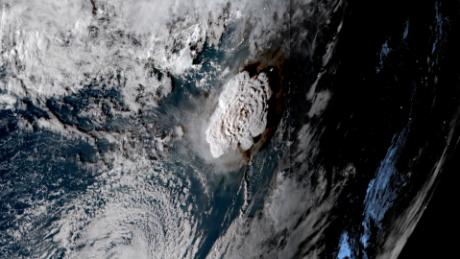
Sign up for CNN’s Wonder Theory science newsletter. Explore the universe with news on fascinating discoveries, scientific advancements and more.
(CNN)One of the most powerful volcanic eruptions on the planet blasted such a massive amount of water vapor high into the atmosphere that it’s likely to temporarily warm the Earth’s surface, according to detections from a NASA satellite.
When the undersea Hunga Tonga-Hunga Ha’apai volcano erupted on January 15, 40 miles (65 kilometers) north of Tonga’s capital, it created a tsunami as well as a sonic boom that rippled around the world — twice.
The eruption sent a tall plume of water vapor into the stratosphere, which is located between 8 and 33 miles (12 and 53 kilometers) above the Earth’s surface. It was enough water to fill 58,000 Olympic-sized swimming pools, according to detections from a NASA satellite.
The detection was made by the Microwave Limb Sounder instrument on NASA’s Aura satellite. The satellite measures water vapor, ozone and other atmospheric gases. After the eruption occurred, the scientists were surprised by the water vapor readings.
They estimate that the eruption delivered 146 teragrams of water to the stratosphere. One teragram is the equivalent of a trillion grams, and in this case, it was equal to 10% of the water already present in the stratosphere.
That’s nearly four times the amount of water vapor that reached the stratosphere after the 1991 Mount Pinatubo eruption in the Philippines.
A new study about the water vapor findings published in July in Geophysical Research Letters.
“We’ve never seen anything like it,” said study author Luis Millán, an atmospheric scientist at NASA’s Jet Propulsion Laboratory in Southern California, in a statement. “We had to carefully inspect all the measurements in the plume to make sure they were trustworthy.”

